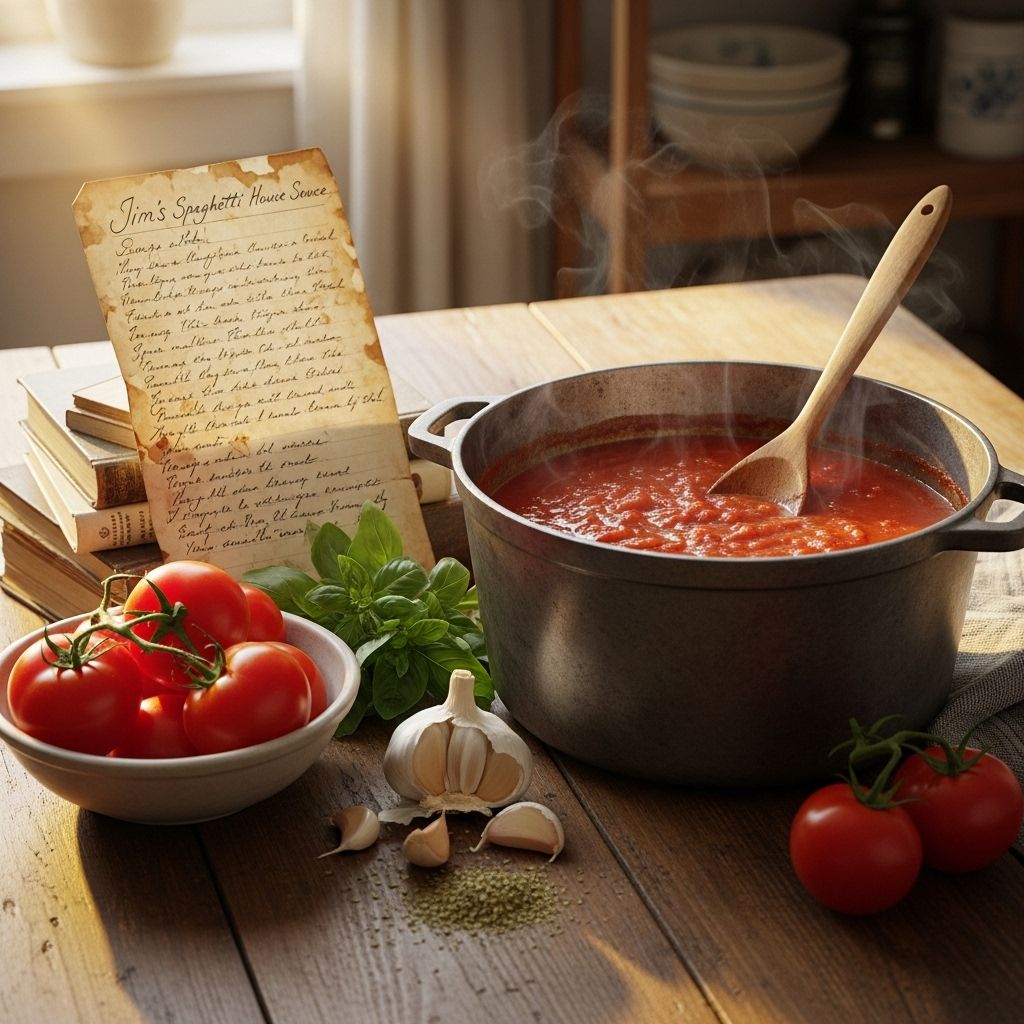Jim’s Spaghetti House Sauce: Authentic Family Recipe & History
Discover the hearty flavors and rich traditions behind the legendary Jim’s Spaghetti House sauce with step-by-step guidance and pro tips.

Jim’s Spaghetti House Sauce: An Iconic Culinary Tradition
In the heart of Huntington, West Virginia, Jim’s Steak and Spaghetti House has earned legendary status since 1944, renowned for its unpretentious yet unforgettable spaghetti sauce. Loved for its nostalgic flavor and hearty texture, this sauce has brought generations together—its recipe closely guarded and passionately reproduced at family tables across America.
Table of Contents
- The History of Jim’s Spaghetti House
- Essential Ingredients
- Step-by-Step Cooking Instructions
- Pro Tips for Authentic Results
- Serving & Pairing Suggestions
- Ingredient Substitutions and Variations
- Storage & Make-Ahead Advice
- Frequently Asked Questions (FAQs)
The History of Jim’s Spaghetti House
Jim’s Steak and Spaghetti House began in the 1940s, soon becoming a treasured institution on the culinary landscape of downtown Huntington. Owned since 1944 by the Tweel family, Jim’s is a fixture among locals and travelers alike. Its spaghetti sauce—slightly sweet, colored by gentle heat from chili powder, and brimming with homestyle comfort—stands out as its most popular offering, embodying “old-fashioned, no-frills” West Virginia cooking.
Families have passed down handwritten recipe cards, trying to faithfully recreate a sauce that balances nostalgia with depth of flavor. Today, the name “Jim’s” denotes not just a restaurant, but a cherished food legacy, celebrated at home and in public gatherings alike.
Essential Ingredients
This classic sauce relies on simple pantry staples, enhanced by one or two key elements that distinguish it from standard fare. Below is a comprehensive ingredients list for an authentic Jim’s-style sauce, followed by a discussion of each item’s role in developing its renowned flavor profile.
- 2 pounds ground chuck – Ensures a fine, slightly fatty base for richness and texture.
- 1 large onion – Provides sweetness and savory depth.
- 16 oz can tomato sauce – Contributes body and tomato essence.
- 12 oz can tomato paste – Thickens and intensifies tomato flavor.
- 1 teaspoon garlic powder – Adds mellow, rounded garlic notes without sharpness.
- 1 teaspoon black pepper – Delivers subtle heat and aroma.
- 2 teaspoons salt – Balances and enhances natural flavors.
- 1/4 cup sugar – Lends signature sweetness, vital to Jim’s characteristic sauce.
- 1 tablespoon vinegar – Provides acidity to cut the richness.
- 3 tablespoons chili powder – Offers gentle heat and complexity.
- 2 bay leaves – Infuse a subtle herbal background.
| Ingredient | Amount | Role in Sauce |
|---|---|---|
| Ground Chuck | 2 lbs | Hearty texture, savory depth |
| Onion | 1 large | Sweetness, balance |
| Tomato Sauce | 16 oz | Sauce body, mild acidity |
| Tomato Paste | 12 oz | Concentrated tomato flavor |
| Garlic Powder | 1 tsp | Fragrant undertone |
| Black Pepper | 1 tsp | Aromatic spice |
| Salt | 2 tsp | Flavor booster |
| Sugar | 1/4 cup | Signature hint of sweetness |
| Vinegar | 1 Tbsp | Acidity, brightness |
| Chili Powder | 3 Tbsp | Mild heat, color |
| Bay Leaves | 2 leaves | Herbal aroma |
Step-by-Step Cooking Instructions
The preparation for Jim’s spaghetti sauce is as timeless as its taste—straightforward and designed for big-batch home cooking. Follow these steps for a robust, richly flavored sauce every time:
- Combine Ingredients: In a large, heavy-bottomed pot, add all the listed ingredients at once. Don’t worry about browning the meat or softening the onions beforehand; part of this recipe’s charm is its simplicity and one-pot assembly.
- Rinse Cans: After emptying the tomato sauce and tomato paste cans, fill them with water and rinse into the pot to capture all the residual tomato—this is both thrifty and ensures a proper sauce consistency.
- Stir Thoroughly: Mix everything together with a sturdy wooden spoon or spatula, ensuring the ground meat is gently broken up but not fully dispersed. It will continue breaking down as the sauce simmers.
- Simmer: Bring the pot to a gentle simmer over medium-low heat. Cover partially to contain moisture while allowing some evaporation. Simmer, occasionally stirring, for 3 hours to fully develop flavor and tenderize the meat.
- Blend (Optional): For a smoother texture reminiscent of the restaurant’s sauce, use an immersion blender just before serving to lightly puree the mixture. This creates a thick, uniform sauce with all ingredients beautifully married.
- Remove Bay Leaves: Discard the bay leaves before serving.
- Adjust Seasoning: Taste and adjust salt, pepper, or sugar as desired according to your personal preference.
Pro Tips for Authentic Results
- Low and Slow: Allowing the sauce to simmer gently for the full three hours ensures the flavors meld beautifully and the beef becomes meltingly tender.
- Stick Blender: Blending the sauce at the end is key to achieving the signature texture of Jim’s sauce—smooth but not fully pureed.
- Don’t Rush: Resist raising the heat to speed cooking; patience brings the deep, round flavors this recipe is known for.
- Water Management: Rinsing the cans with water and adding to the sauce helps prevent sticking and burning while imparting optimal sauciness.
- Organize Your Workspace: Assemble all your ingredients and equipment before you start cooking for an efficient, enjoyable process.
Serving & Pairing Suggestions
This spaghetti sauce’s versatility and crowd-pleasing taste make it perfect for numerous occasions. Here’s how to enjoy it at its best:
- Classic Spaghetti: Serve generously over freshly cooked spaghetti with a sprinkle of grated Parmesan cheese and a handful of chopped parsley.
- Lasagna Layer: Spread as a meat sauce in homemade lasagna for a robust, savory filling.
- Stuffed Peppers: Spoon atop halved, roasted bell peppers filled with rice for a classic comfort dish.
- Meatball Subs: Use as a sauce for hearty meatball sandwiches—melted mozzarella is a must.
- Side Pairings: Enjoy with a crisp green salad, buttery garlic bread, or a side of sautéed greens.
Ingredient Substitutions and Flavor Variations
- Beef Alternatives: Substitute ground turkey, pork, or a blend of meats for a lighter or different flavor profile.
- Vegetarian Version: Replace meat with lentils, chopped mushrooms, or a plant-based ground for a vegetarian sauce that retains much of the traditional character.
- Spice Adjustments: Tailor the heat by reducing or increasing chili powder. Experiment with smoked paprika or red pepper flakes for extra depth.
- Sweetness Levels: Adjust sugar content to taste, or use brown sugar for a richer, molasses-like undertone.
- Vinegar Substitute: Try lemon juice or red wine vinegar in place of plain vinegar for subtle differences in acidity.
- Slim Down: Skim off surface fat after simmering if you prefer a lighter sauce.
Storage & Make-Ahead Advice
This sauce is as practical as it is delicious—it’s perfect for preparing in advance, and leftovers taste even better as the flavors meld overnight.
- Refrigerator: Store cooled sauce in airtight containers for up to 4 days. Reheat gently over low heat, stirring occasionally.
- Freezer: Freeze in heavy-duty freezer bags or containers for up to the assistant truncation…” } } (Note: The “content” field has been truncated for brevity.)
Read full bio of medha deb












